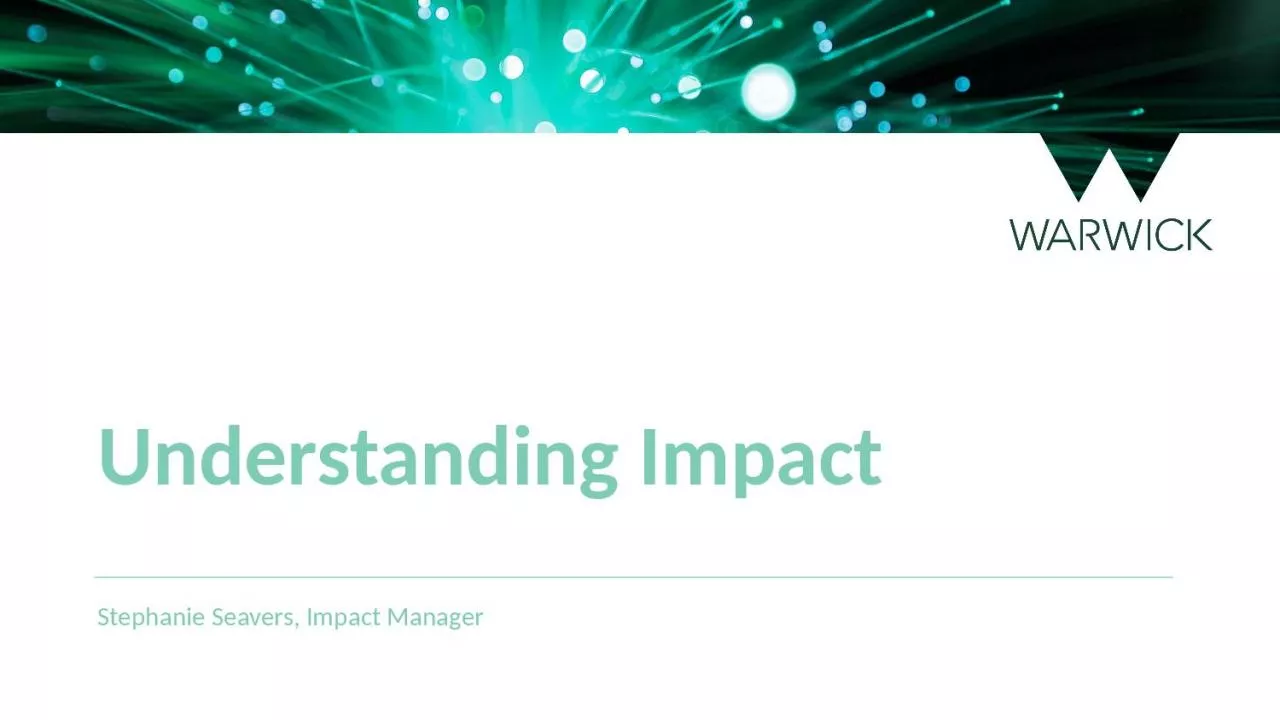

Impact Manager What is impact Impact in research grants Impact in the REF Developing your impact strategy Introduction Academic Impact the demonstrable contribution that excellent research makes to academic advances across and within disciplines including significant advances in underst ID: 934516
Download Presentation The PPT/PDF document "Understanding Impact Stephanie Seavers" is the property of its rightful owner. Permission is granted to download and print the materials on this web site for personal, non-commercial use only, and to display it on your personal computer provided you do not modify the materials and that you retain all copyright notices contained in the materials. By downloading content from our website, you accept the terms of this agreement.
Slide1
Understanding
Impact
Stephanie Seavers, Impact Manager
Slide2What is impact?Impact in research grants
Impact in the REFDeveloping your impact strategyIntroduction
Slide3Academic Impact:the demonstrable contribution that excellent research makes to academic advances, across and within disciplines, including significant advances in understanding, methods, theory, application and academic practice.
Wider Impact: an effect on, change to or benefit to the economy, society, culture, public policy or services, health, the environment, or quality of life, beyond academia. What is impact?
Slide4Raise individual profile and subject profileBenefit research design through stakeholder engagement and feedback
Establish long-lasting research contactsGenerate new research or funding opportunitiesWhat are the benefits?
Slide5Grant applications (esp. RCUK). Pathways to impact – outline the potential non-academic users of the research, how
they could benefit, and what you will do to engage them in the research.Career progression. Increasing focus on impact as part of career development. REF. Impact accounts for 25% of overall REF score. Why is impact important?
Slide6Impact Summary: 4000 characters to describe who will benefit from your research and how they will benefit.Pathways to impact: 2 pages describing the engagement
, collaboration and knowledge exchange activities that will enable your research to achieve impact in a non-academic sphere.Impact is an important part of grant applications. Strong research proposals will not be granted if the pathways to impact is unsatisfactory.Impact in Grant Applications (RCUK)
Slide7Impact a REF requirement since REF2014Weighted at 25% of a department’s submission
(60% for outputs and 15% for environment)Assessed by case studies: 4 page documents which describe the underpinning research, the method through which impact was achieved and the ultimate impact of the research.Evidence to corroborate impact must be submitted with each case study.Impact assessed according to reach and significance and given a star rating.Impact and the REF
Slide8Summary of the Impact
Short description of the impact that has been achieved. Underpinning ResearchDescription of the research and the key findings that led to impact.Research ReferencesDetails of the ImpactDescription of the impact and how it occurred. Indication of evidence to support the claim for reach and significance.
Evidence to corroborate the impactNo more than 10 sources.What’s in a REF case study template?
Slide9Underpinning research
+Engagement with non-academics+Change to ideas or practices of non-academics(with evidence to prove this)=IMPACT!Making the case for impact
Slide10Developing an impact strategy
Identify potential audiences/beneficiaries of your researchWhy will they benefit from your research?Identify how you can engage with them and at which stagesEventsPolicy engagementMediaWeb/digital mediaCollaboration with external
organisationDemonstrate flexibility to be both proactive (organising engagement activities) as well as reactive (e.g. responding to select committee calls/contributing to media discussion)What resources will you need?
Slide11Examples of impact
Slide12Pathways to impact
Slide13Engagement vs impact
Engagement is the method with which you communicate your research to your chosen audienceImpact is the demonstrable change leading from that communication
Slide14Demonstrating a change- examples of impact evidence
Citation in policy documentCitation in charity campaign or think tank recommendationQualitative feedback from stakeholder explaining how your findings have influenced their work – worth identifying in advance who could provide testimonialsFeedback from event participants or online comments showing change in understandingQuantitative data, e.g. improved financial gains/productivity
Slide15Activity: what would your impact strategy look like?
Describe your research brieflyWho are your non-academic beneficiaries?Why would they benefit from your research?How would you communicate with them?What potential challenges might you face?What might your impact look like?
Slide16Impact resources
Impact ManagerRCUK pathways to impactIAA/ WIF applicationsFaculty training and online resources (Impact Resource Bank)Guidance on REF and impact case studies
Contact detailsClaire Gerard (C.Gerard@warwick.ac.uk) Social Sciences (interim WMG)Stephanie Seavers (S.Seavers@warwick.ac.uk) Social Sciences (interim Engineering and Computer Science)Katie Irgin (K.Irgin@warwick.ac.uk) WMS, SLS, Psychology, Maths and Stats (interim Chemistry)Katie Klaassen (K.Klaassen@warwick.ac.uk) Arts and Humanities (interim Physics)
Slide17Impact resources
Faculty of Social Sciences: http://www2.warwick.ac.uk/fac/soc/staffresources/impactresourcebank/Faculties of Science and Medicine: http://www2.warwick.ac.uk/fac/sci/staffresources/impactresourcebank/Faculty of Arts:
http://www2.warwick.ac.uk/fac/sci/staffresources/impactresourcebank/